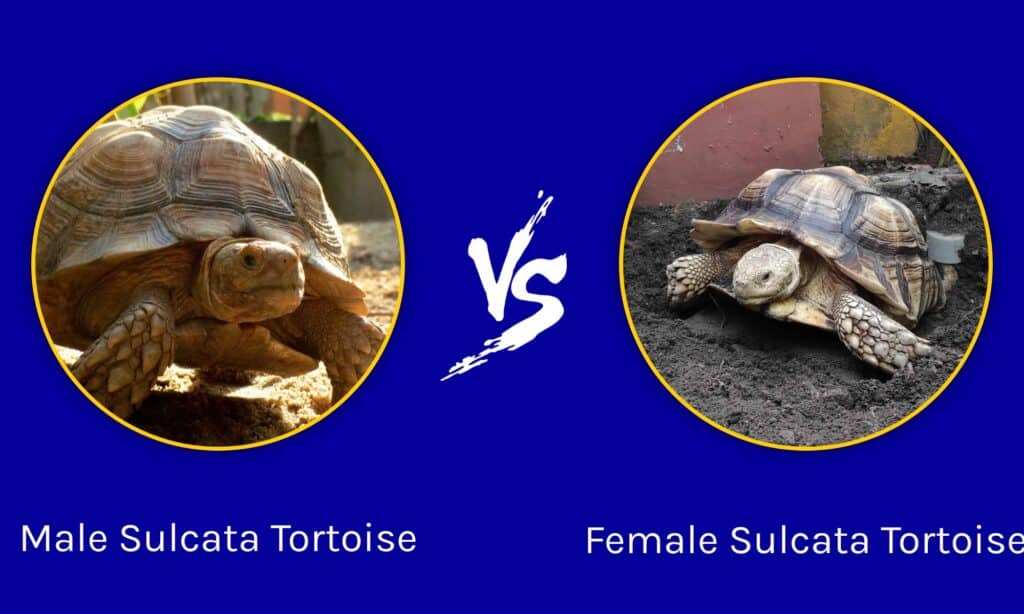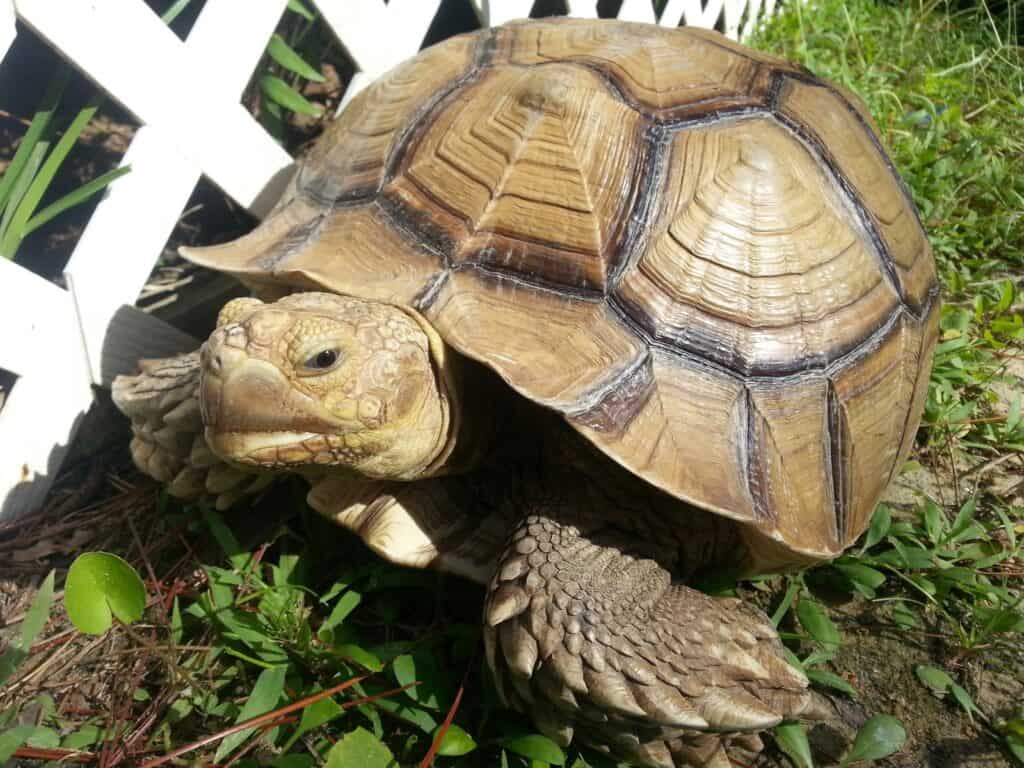Sulcata tortoises, known as African spurred tortoises or Centrochelys sulcata, are one of America’s most popular reptile pets. Sulcata tortoises belong to the Testudinidae family of tortoises. These land turtles have sandy colorations, prominent scales, and marginal scutes.
They can weigh around 79-200 lbs (36 to 91 kg) and grow up to 30 inches (76 cm). Their main diet comprises plants high in fiber and low in protein. Sulcata tortoises primarily feed on grasses, hays, and succulents. They do not require huge amounts of water. Studies show that their thick, scaly skins prevent water loss.
Differentiating the sex of juvenile sulcata tortoises is very difficult. Some breeders think it is almost impossible to tell them apart with certainty if they are less than 15 inches (38 cm) long or weigh less than 10 to 15 pounds.
Comparing Male vs. Female Sulcata Tortoise

| Male Sulcata Tortoise | Female Sulcata Tortoise | |
|---|---|---|
| Color Variations | Brown, yellow | Brown, yellow |
| Skin Type | Large spurring scales | Large spurring scales |
| Diet | Herbivore | Herbivore |
| Habitat | Desert, dry savanna | Desert, dry savanna |
| Origin | Africa | Africa |
| Sexual Maturity | 15 years | 15 years |
| Lifespan | More than 70 years | More than 70 years |
The Key Differences Between Male vs. Female Sulcata Tortoises
The most obvious difference between adult male and female sulcata tortoises is their tail length. However, if you look closely, parts of their shell differ too, depending on their function. It is important to note that the shell of the sulcata tortoise is part of the skeletal system. Some major anatomical parts of the male and female sulcata tortoises differ. These include the carapaces, plastrons, gular scutes, and anal scutes. Check out the following six features that help distinguish a female sulcata tortoise from a male.
Male vs. Female Sulcata Tortoise: Carapace

Male sulcata tortoises have carapaces that extend longer up to underneath their back, protecting their manhood.
©Chase D’animulls/Shutterstock.com
Did you know that sulcata tortoises are the third largest tortoises in the world? Previous studies show that the maximum recorded sulcata tortoise carapace length is 2.7 feet (82 cm), and the maximum recorded weight is 105 kg (about 240 lbs.)
The carapace is the top or the dorsal part of the shell of a tortoise. The exterior of the carapace comprises pyramid-shaped plates made of keratin, just like what our hairs and nails are made of. These horny plates are called scutes. The inside of the shell, which is also the back of the carapace, is actually an extension of their ribcage.
Male sulcata tortoises have carapaces that extend longer up to underneath their back, protecting their manhood. Female sulcata tortoises have shorter carapaces that do not cover underneath their back, allowing a male sulcata tortoise to penetrate during mating.
Male vs. Female Sulcata Tortoise: Plastrons
The plastron is the bottom part of the tortoise’s shell. Some studies show that they are exoskeletons. The male sulcata tortoise has a concave plastron that allows it to mount the female sulcata tortoise during mating. In contrast, the female Sulcata tortoise has a flat plastron.
Male vs. Female Sulcata Tortoise: Gular scutes
The gular scute, the anterior part of the plastron, covers the underside of the shell. Some breeders think the male sulcata tortoises have larger and more pronounced gular scutes than females. One reputable tortoise breeder showed a trick on how to easily tell if the gular scute of a Sulcata tortoise belongs to a female or a male. He says that the V-sign hand gesture (peace sign) will correspond to the male’s gular scute form. In contrast, if you fold these two fingers, they’ll have a shape similar to a female’s gular scute.
Male vs. Female Sulcata Tortoise: Anal scutes
Like most animal species, the most distinctive anatomical difference between male and female tortoises is their anal part. Studies show that the male sulcata tortoises have a shallow, widely flared anal scute curvature. The female anal scute has a U-shape and is deeper and narrowly flared so that they can deposit their eggs.
Male vs. Female Sulcata Tortoise: Tails
The tail of the male sulcata tortoise is longer compared to the female sulcata tortoise tail.
Male vs. Female Sulcata Tortoise: Mating and Nesting Behavior

The female sulcata can lay around 15 – 30 eggs.
©TinaO/Shutterstock.com
Sulcata tortoises can breed all year round, and they breed well even in captivity. However, male and female sulcata tortoises behave differently when mating and nesting. According to sources, Sulcata tortoises reach sexual maturity at 5 years old, as long as they weigh 25 to 40 lbs. Other studies indicate that a male Sulcata tortoise becomes sexually mature when its carapace is about 13.8 inches (35 centimeters) in diameter. Before mating, a sexually mature sulcata male will court an adult female.
The male might get into a fight with another male if both are trying to catch the female’s attention. These fights include a lot of loud groaning, whistling, grunting, and sometimes blood is shed. The conquering male will lead the female to an obstacle by nudging, ramming, steering, or getting ahead of it. The male basically forces the female to let it mount her.
After mating, the female sulcata’s body will expand with eggs. Her food consumption will also increase. A diet rich in fiber is essential. Nesting begins six to eight weeks after mating. Before laying the eggs, the female Sulcata tortoise will find a suitable nest site and begin digging using its hind legs. Sulcata tortoise nests are about 2.7 to 5.5 inches deep (7 to 14 cm).
The female sulcata can lay around 15 – 30 eggs. Once the eggs are laid, it will exhibit a certain degree of aggression and will become protective towards its nest.
Do Sulcata Tortoises Like to be Touched?
Similar to how some people embrace their friends while others avoid hugs. It all depends on the turtle, its personality, and its history with human contact. There are tortoises that genuinely relish having their shells scratched, while some may not prefer it as much.
Nevertheless, we have compelling evidence that many tortoises derive pleasure from being touched and receiving attention. In contrast to what some sellers may suggest, it’s not advisable to handle tortoises frequently because they are prone to stress easily.
Adult Sulcatas, particularly males, can exhibit territorial behavior. They often patrol the enclosure’s perimeter and may even display charging behavior when someone enters their territory.
The photo featured at the top of this post is © Osa Sumanohara/Shutterstock.com
Sources
- University of Michigan, Available here: https://animaldiversity.org/accounts/Geochelone_sulcata/#:~:text=When%20mating%2C%20the%20male%20first,season%20is%20in%20the%20autumn.
- World Chelonian Trust, Available here: http://www.chelonia.org/articles/sexingsulcata.htm
- National Academy of Science, Available here: https://doi.org/10.1073/pnas.1600958113
- Google Books, Available here: https://books.google.com.ph/books?hl=en&lr=&id=c9rhHw3PWo8C&oi=fnd&pg=PA1&dq=largest+Desert+Tortoise&ots=wX0do8DtAX&sig=QcCeKqicP6vaGIFO4QeEuScCMxU&redir_esc=y#v=onepage&q=largest%20Desert%20Tortoise&f=false
- The Spruce Pets, Available here: https://www.thesprucepets.com/sulcata-tortoise-1237267
- Tortoise Trust, Available here: https://web.archive.org/web/20151105043223/http://www.tortoisetrust.org/care/csulcata.html
Thank you for reading! Have some feedback for us? Contact the AZ Animals editorial team.






